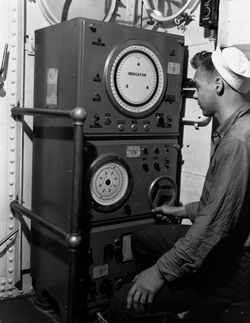
One month ago this week, Malaysia Airlines Flight 370 vanished from the face of the Earth — or into the face of the Earth, into its waters, into total and upsetting silence — and ever since, I have been thinking about the word ping. After all human communication from the airplane ceased, the plane itself, a Boeing 777, sent out one last “partial ping”: an automated but incomplete attempt to communicate with a satellite, as commercial airplanes normally do every hour while in operation. Analysis of that partial ping suggested that the plane had gone down somewhere in the south Indian Ocean, a conclusion now supported by all official investigations. Several days ago, those closest to the search grew hopeful that the plane would finally be found, after ships in the area detected underwater signals consistent with the kind transmitted by flight recorders: pings.
What is a ping? As a word, it already seems partial, like a suffix: beeping, keeping, hoping, gaping, dropping, stopping, ___-ping, ping. In fact, though, it is an onomatopoeia; it has no linguistic origins, no etymology but noise. It comes from the sound of things that go ping. In recent years, those things have mostly been electronic, and we now use the word to mean, basically, “get in touch via gadget”: “Ping me in the morning.” As that usage grows more common, it is starting to annoy some people, and for good reason; it can feel simultaneously self-important and inhuman, like the MBA version of the juvenile poke. In its defense, though, the word fills a new linguistic need, while cleaving close to its precedent: “Ring me.” It is also a word with a past, one that predates smartphones and chat apps and jets — and airplanes in general, and telephones in general, and, for that matter, all electronics. According to the Oxford English Dictionary, it was first used in 1833. Back then, it referred to “An abrupt ringing sound, such as that made by a rifle bullet in flying through the air, [or] by a mosquito.” On second thought: Don’t ping me in the morning.

Eventually, of course, other things began to ping: shop bells, doorbells, typewriters (I sometimes yearn for that congratulatory end-of-the-line chime), bicycle bells, automobile engines with something amiss, sonar. The last was crucial to the development of pinging as we understand it today. Sonar operates by emitting a pulse of sound — a ping — and listening for the echo. It came into widespread use during World War II, when ships began deploying it to detect enemy submarines. (In Navy slang, a sonar operator was a “ping man.”) The process was imperfect — whales, the wake from ships, schooling fish, and ocean currents were all routinely mistaken for U-boats — but it still saved a lot of lives. It also permanently altered the meaning of ping. For one thing, the word came to imply an electronic sound, rather than just any high-pitched noise. For another, it came to imply a question — are you there? — as well as that question’s answer.
Technological jargon, once established, tends to stick around, often jumping from old contraptions to their newer incarnations. (Even when they play Beyoncé, our cell phones still “ring.”) In 1983, the computer scientist Michael Muuss, looking to troubleshoot problems in an IP network, wrote some lines of code that that instructed a host computer to send an echo request — basically, a message saying “please respond” — to a destination computer, then measure how long it took for a reply to arrive. Muuss called his creation Ping, after the pulses sent out by sonar. (The name is now sometimes said to stand for “Packet InterNet Groper,” but that is a backronym — an acronym formed after the fact.)
As we use it today, then — in ships, in airplanes, in networks, with each another — a ping is a form of communication whose sole content is an entreaty: Please respond. It is a request for affirmation of existence. Or, more broadly, it is both the request and the affirmation itself: We ping in search of connection, and we ping to indicate our presence. It is the latter sound we hope to hear this week, as a device called a Towed Pinger Locator searches the Indian Ocean for a missing plane, like a child playing Marco Polo, in an unimaginably large pool, alone.
In 1966, after sonar but before SMS, Samuel Beckett wrote a short story he called “Ping.” Its length (under two pages) belies its difficulty (extreme). The text seems to consist of the stilted, incomplete transmissions of a consciousness in distress: a mind trapped in a small white room, perhaps in a hospital, perhaps on the edge of death. The “ping” of the title recurs throughout, chirping like life support or, conversely, like an unanswered call button. “Bare white body fixed one yard ping fixed elsewhere.” “Ping perhaps away out there one second ping silence.” It ends like this: “… ping last murmur one second perhaps not alone eye unlustrous black and white half closed long lashes imploring ping silence ping over.”
Beckett was right, of course. Everything stops pinging eventually: beacons, batteries, life support, life. The worst-case scenario, for MH370 as for us all, is silence. That’s what scares us most: the possibility that there is nothing to hear — or, when we ourselves are pinging, no one to hear it. Sound, by contrast, is hope. And so the ping is hopeful. In nothing but electrical impulses, it expresses our deepest human ones. It says: Is anybody out there? And: I am here. And: Hold on, I’ll find you.





























